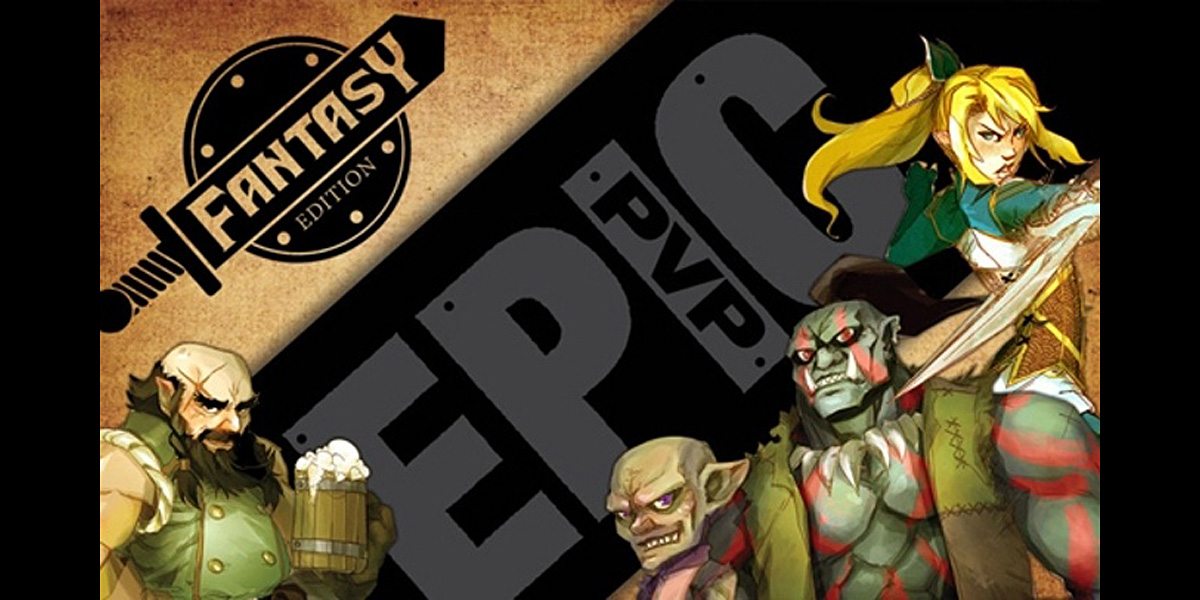“Reaping the Rewards” is a series about completed crowdfunded products. Today’s title is Epic PvP: Fantasy, a card game featuring battles between your favorite fantasy characters. While there are rules for 3-player games and a 2-on-2 team battle, the core game is the 1-on-1 battle.
At a glance: Epic PvP: Fantasy is a game by Ryan Miller and Luke Peterschmidt for 2 to 4 players, ages 10 and up, and takes about 20 minutes to play. The game retails for $29.99, with an expansion available for $19.99. It was funded in February 2015, and was shipped to backers in November and December (though with some delays for overseas backers). It’s jointly published by Fun to 11 Games and AEG.
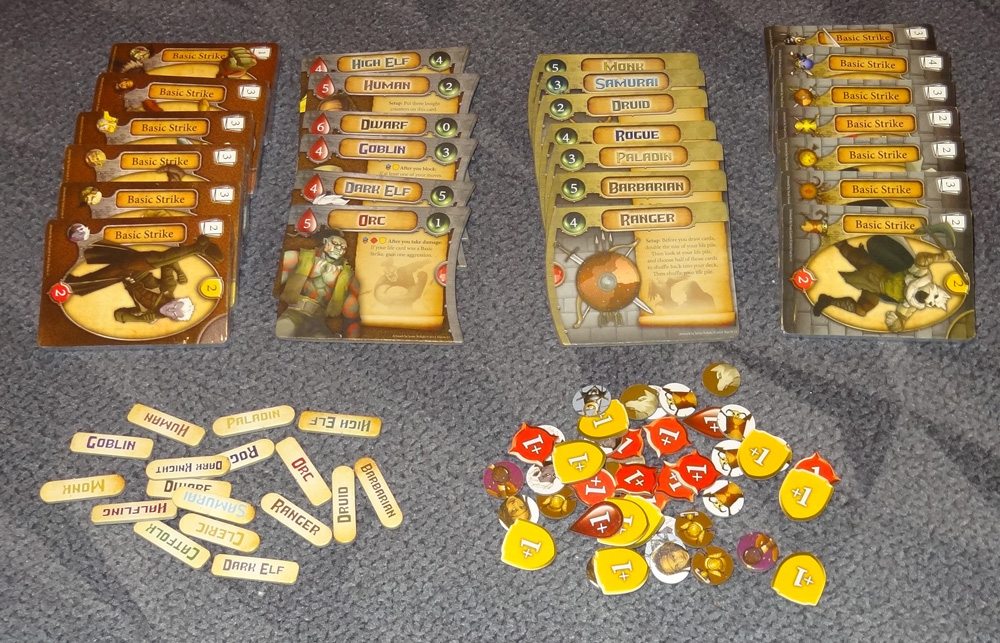
Components:
Epic PvP: Fantasy was funded on Kickstarter, and Kickstarter backers got access to some bonuses, like a Samurai class deck and a fancy box. (Really fancy.)
The Base Game contains:
- 4 Race decks (Goblin, High Elf, Human, Dwarf)
- 4 Class decks (Paladin, Rogue, Ranger, Druid)
- Boards for each Race and Class
- Tokens for randomizing race/class
- Health, Attack, Defense tokens
- Some class- or race-specific tokens
The expansion includes:
- 2 Race decks (Dark Elf, Orc)
- 2 Class decks (Monk, Barbarian)
- Boards for each Race and Class
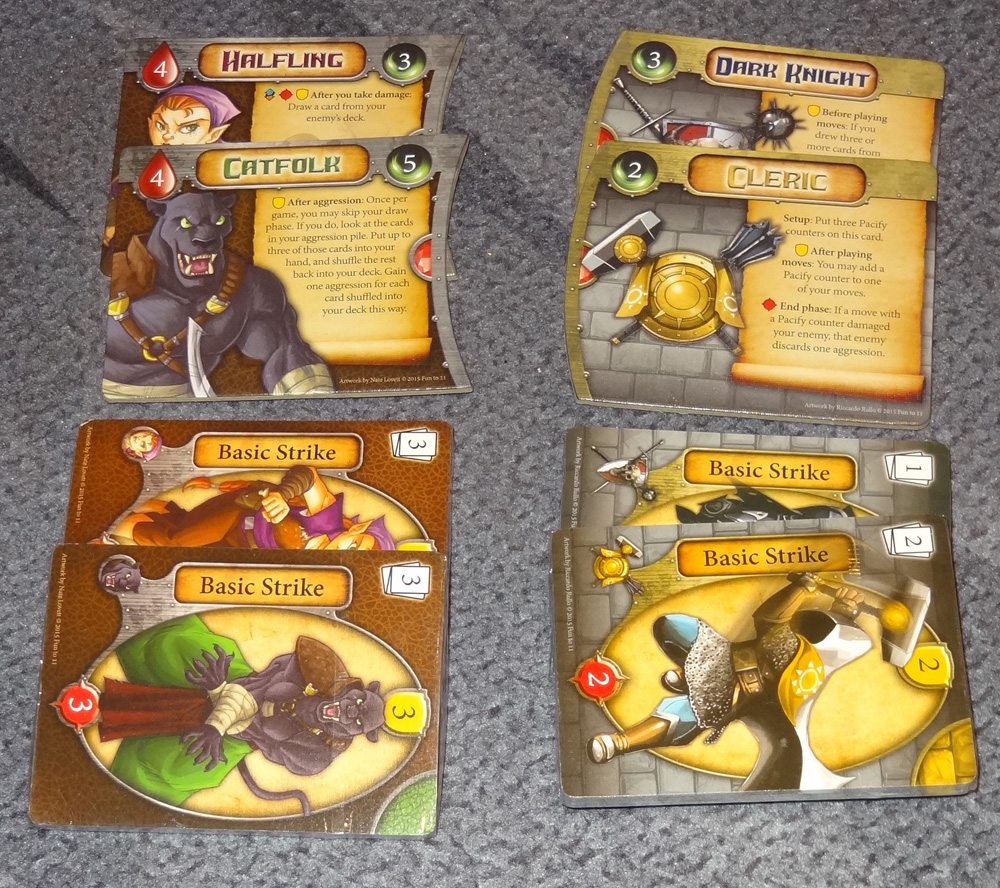
I was also given the Kickstarter add-on decks and a bonus deck:
- 2 Race Decks (Halfling, Cat Folk)
- 3 Class decks (Dark Knight, Cleric, Samurai)
- Boards for each Race and Class
Presumably the add-on decks will also be made available later as an expansion, though the Samurai was the Kickstarter bonus deck and if it becomes available it will be sold separately.
The Race and Class decks all share the same back (since they’ll be shuffled together), but the faces have different backgrounds so you can sort them back out at the end of the game. In addition, each card has a small icon at the bottom left indicating its Race or Class. I did think it was a little odd that the Race and Class names aren’t printed on the cards anywhere, but I suppose they wanted to use just the icons instead.
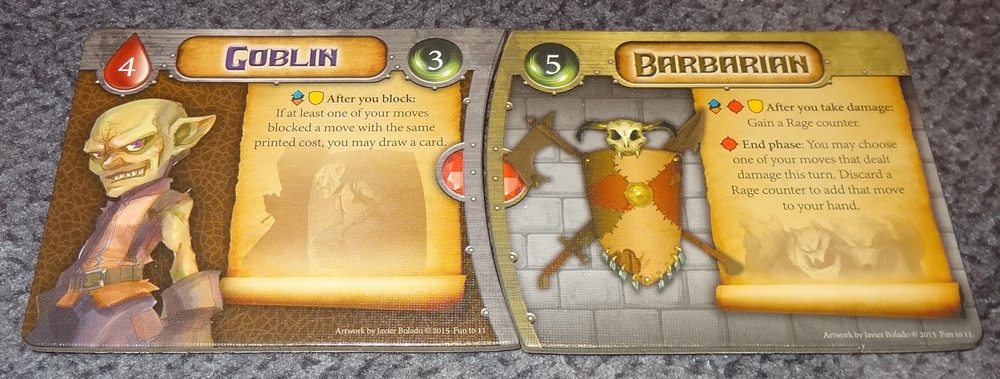
The Race and Class boards are slightly curved on the matching edges, so you place them next to each other. The Race board has your health. Both sides have special abilities, and a green number for your initiative. Your initiative is the sum of the two numbers.
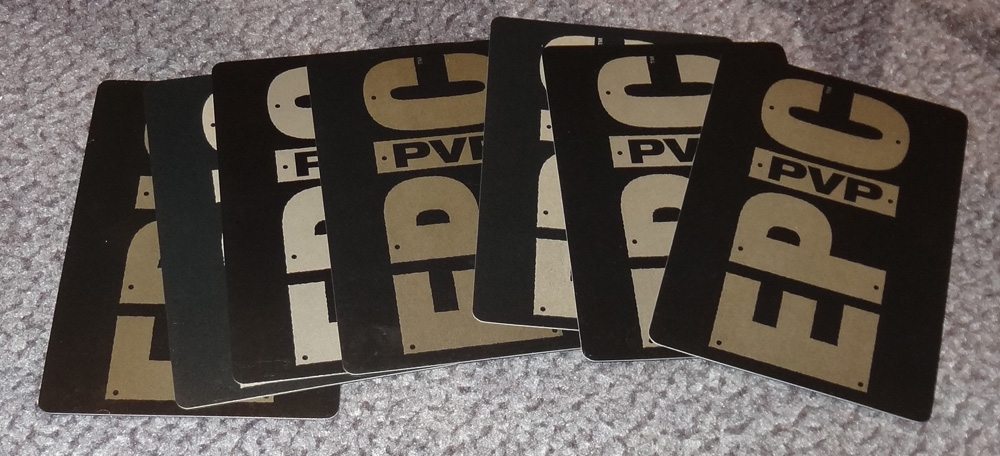
I did notice that some of the card backs did not match–this has been noted in the forums on BoardGameGeek, and players were directed to fill out this form for customer service issues.
How to Play
You can download a print and play version here if you want to try out the game yourself.
The object of the game, as you might imagine, is to eliminate the other player by depleting their life pile.
To set up, you choose a Race and Class, take the corresponding boards and decks, and then shuffle the two decks together to form your own deck. You can use the randomizer tokens, or just pick whatever you like. Your Race and Class boards are set on the table in front of you, leaving space to play cards between the two players. Your Race board shows your health–draw that many cards from your deck (without looking) and place it to the side as your life pile. The rest of the cards go in your draw deck. You’ll also have an aggression pile in front of your boards, and your own discard pile.
Draw a starting hand of five cards. The player with the highest total initiative (as shown on the Race and Class boards) goes first.
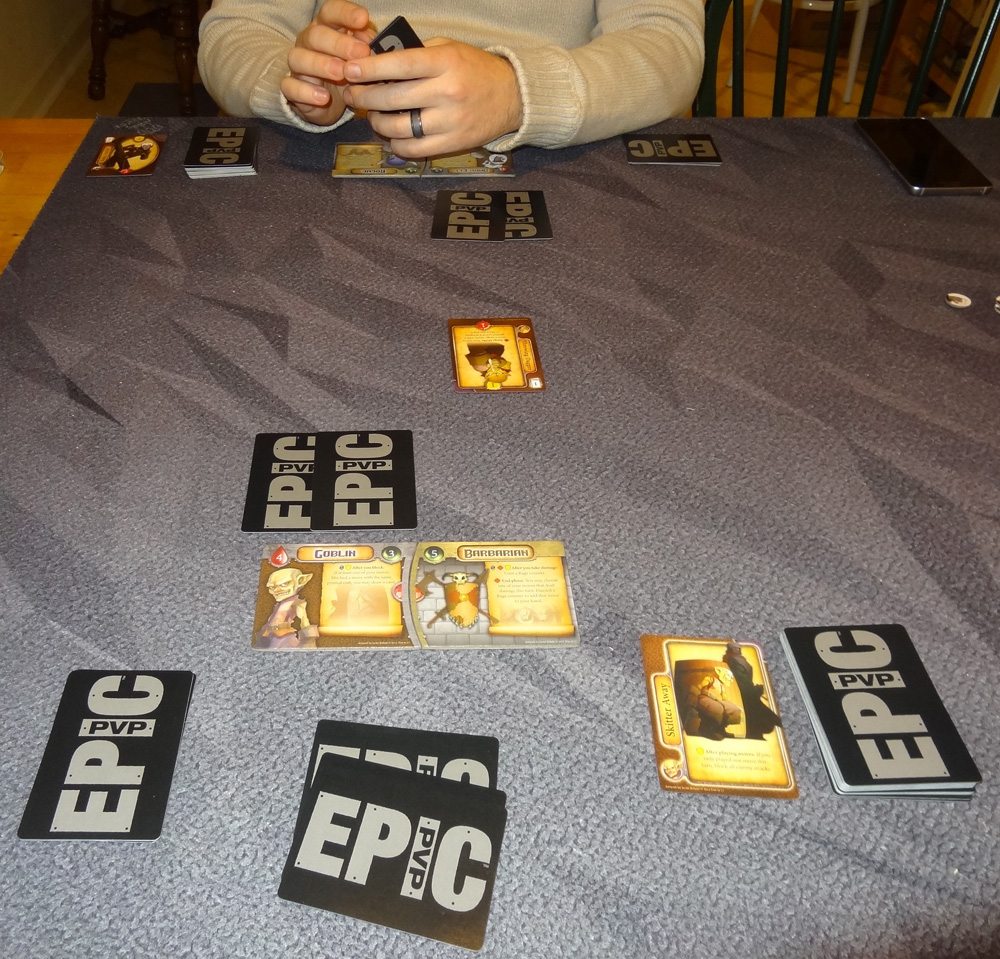
Your turn has seven phases:
- Aggression: Add two cards from your deck to your aggression pile without looking at them.
- Draw: You may draw any number of cards from your aggression pile, but you must announce how many you are drawing before you begin.
- Play Moves: Play cards from your hand into the area between the two players. The cost to play a card is shown at the top left–your total cost must be less than or equal to the number of cards in your aggression pile.
- Assign Blocks: You may assign your moves to block your opponent’s moves that are in the play area. Each defense may only block one move, and each move may only have one defense assigned to it. The defense value must be at least as high as the move’s attack value.
- Block: Defenses take effect, as well as some abilities.
- Take Damage: For each unblocked attack, you take 1 damage (regardless of the attack value), discarding 1 card from your life pile.
- End phase: Turn your moves around so the attack values are facing your opponent. Any “end phase” abilities are triggered. All of your opponent’s moves are discarded.

Most of your cards are move cards, with some values for attack and defense, and sometimes other special abilities. There are also some skill cards, which will either have some immediate effect (and are then discarded) or permanent abilities (and are placed next to your boards).
If you ever run out of cards in your deck, you take 1 damage, and then reshuffle your discard pile to form a new draw deck.
When somebody runs out of cards in their life pile, they lose and the game is over.
Variants
For 4 players, you play 2-vs-2 teams, and you share a life pile with your teammate but each of you have your own aggression pile. You and your teammate take your turns simultaneously, and you may block any moves, not just from one player. Win by running the other team out of life.
For 3 players, it’s a free-for-all. If you assign a move as a block, then it must attack the player whose move you blocked. Moves that don’t block anything may attack either player. Last player standing wins.
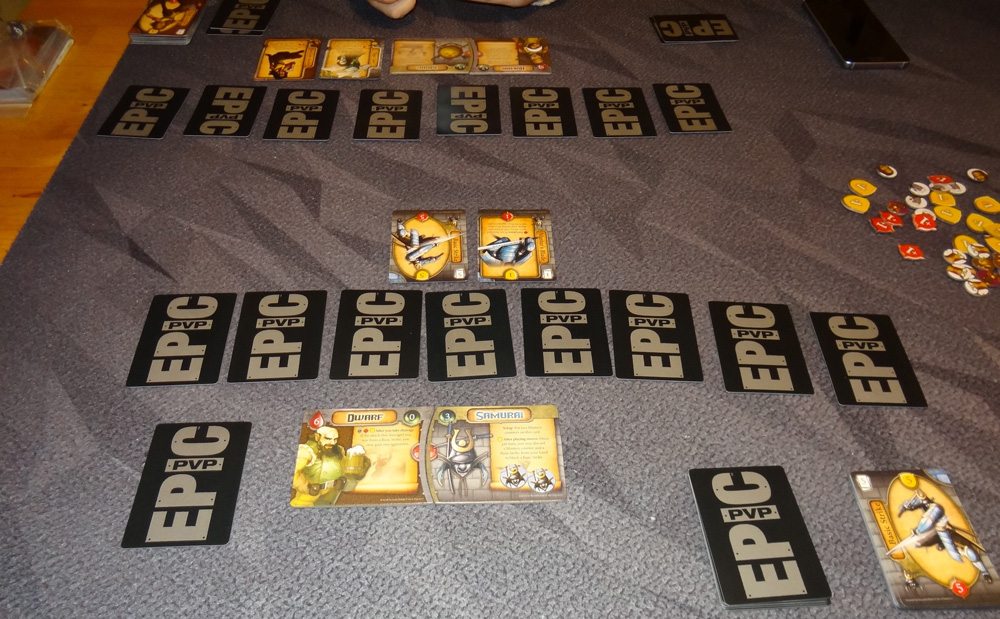
The Verdict
The concept of picking two decks and shuffling together may remind you of Smash Up, although that’s the main thing the games have in common. Because of that, I would also say that some combinations will work better than others. The Dwarf Samurai I tried, as it turns out, wasn’t so great.
Each of the decks–Race and Class decks–has moves, Basic Strikes, and a few skill cards. There are quite a few abilities that affect or are affected by Basic Strikes, which don’t have any special abilities themselves. Skills often have no aggression cost, but have a specific effect other than attack and defense.
The more powerful the card, the higher the aggression cost–so you’ll want to build up your aggression pile. On the other hand, when you draw new cards they come from your aggression pile. That balance of building up vs. aggression is a key part of the game.
The other interesting feature is the way the attacks and defense work. Since every card will do 1 damage, whether its attack value is 1 or 8, you want to defend against as many of them as possible. Some characters have a lot of low-cost, low-value attacks, and you just count on one attack slipping through the defenses. Others may have really expensive, high-value attacks, in which case you hope that your opponent doesn’t have a card high enough to defend against it.
I like the various Race and Class abilities, both on the boards and in the cards. They feel thematically appropriate, and there’s also a good bit of humor in the game. So far I’ve only tried a few combinations, and with so many races and classes to choose from, there’s a huge replay factor.

Now, about that Kickstarter box: it’s a thing of beauty. If you missed the Kickstarter, that’s too bad. I mean, the game itself will play the same no matter what, but the Kickstarter box stands upright with a magnetic flap and three sliding drawers for the Race, Class, and tokens.
Overall, Epic PvP: Fantasy is a great two-player game with some nice depth of strategy, but it’s not too difficult to learn. I’m looking forward to trying out more combinations and different tactics. Fun to 11 Games has already announced the next title in the series, Epic PvP: Magic, though they haven’t decided yet whether it will be a Kickstarter project. Either way, it’s something to watch for!
Disclosure: I received a review copy of this game.
